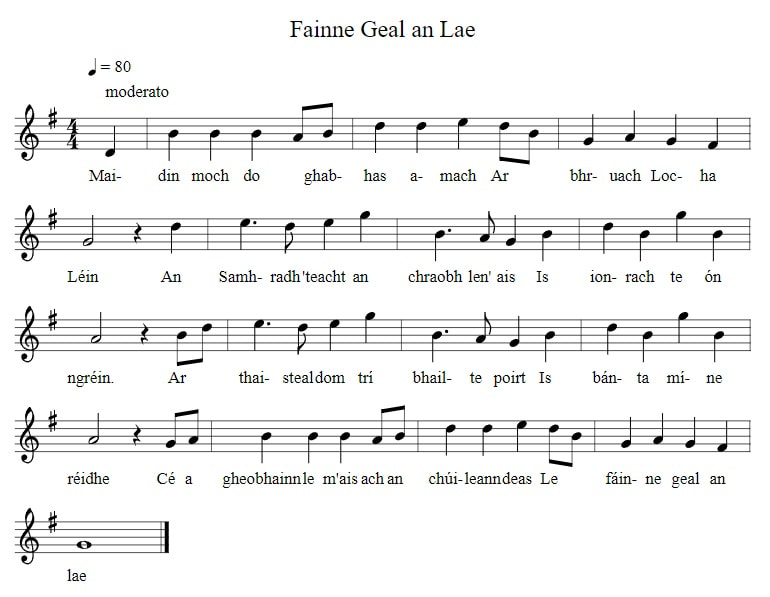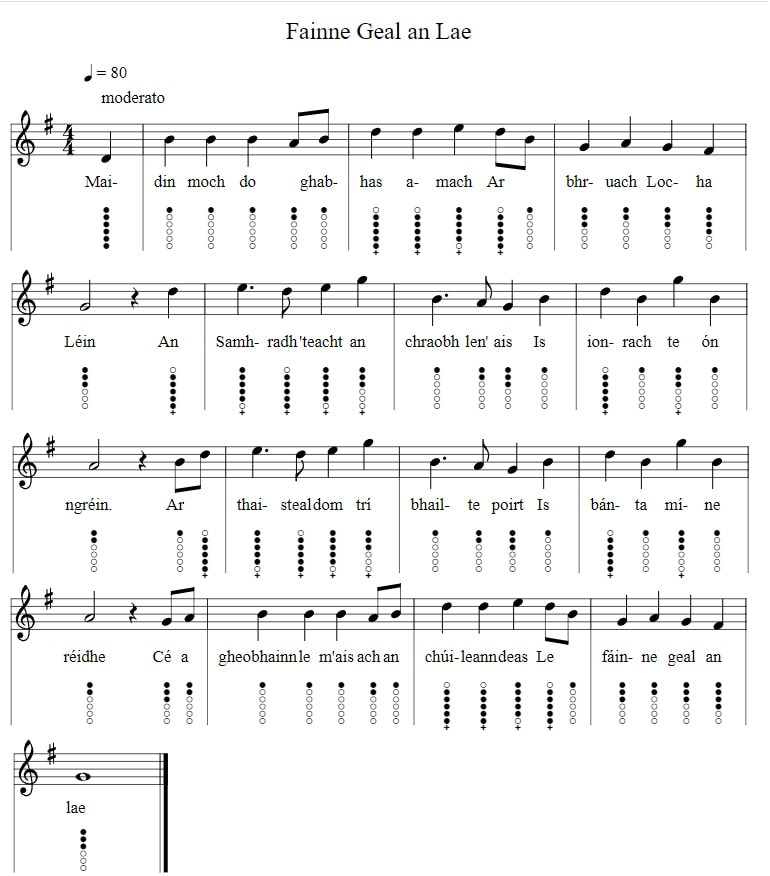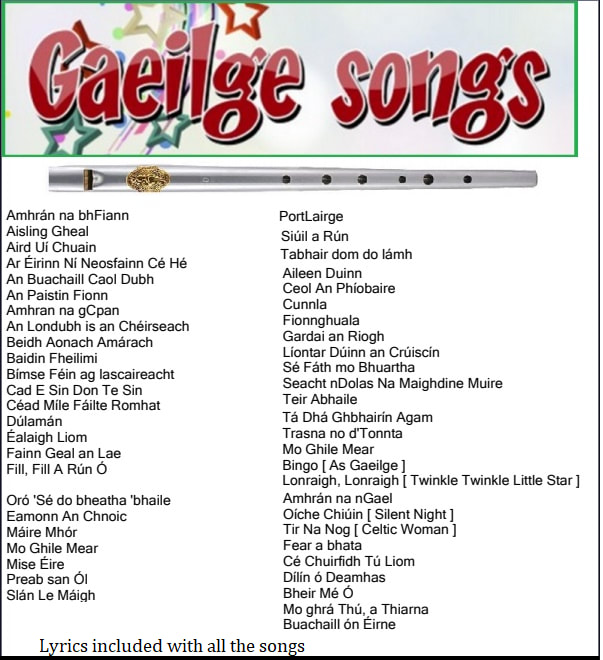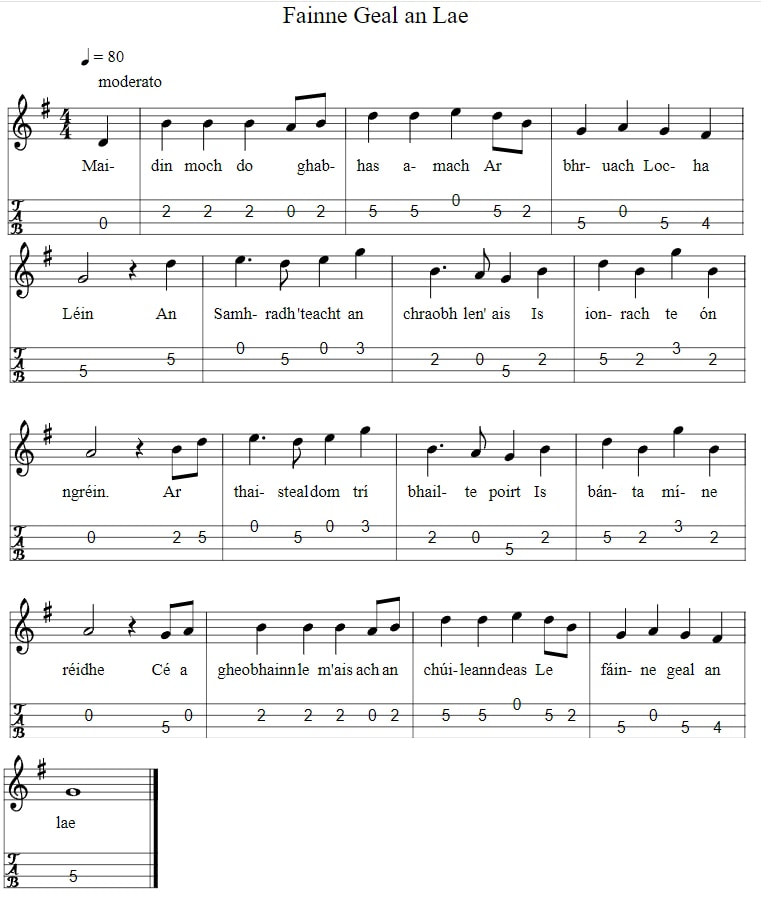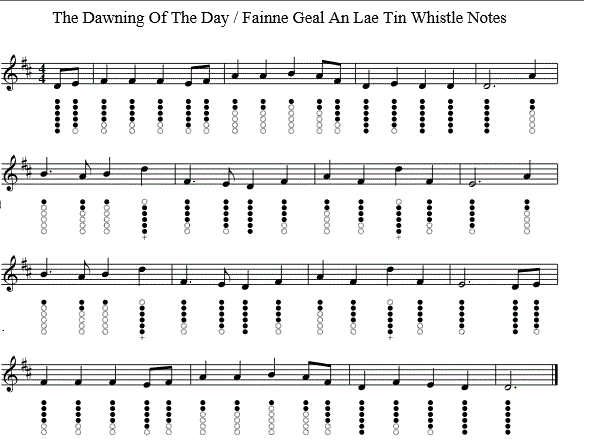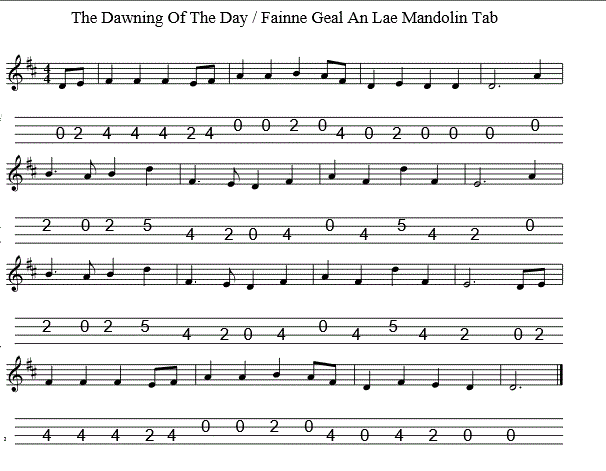FAINNE GEAL AN LAE lyrics and chords
(See The Dawning Of Day Lyrics And Chords in English) 4/4 The sheet music for tin whistle and banjo / mandolin is included. List of my As Gaeilge songs .
As played by Na Casaidigh (Use Capo on 1st fret). Written by Thomas Connellan who was a blind Harper from the Sligo area.
As played by Na Casaidigh (Use Capo on 1st fret). Written by Thomas Connellan who was a blind Harper from the Sligo area.
The Irish folk song 'Fainne Geal an Lae' has long been a beloved and iconic representation of Irish culture. Its haunting melody and poignant lyrics have resonated with generations of listeners, both within Ireland and around the world. Despite being written over a century ago, the song's relevance and popularity have endured, making it a timeless piece of Irish music.
The origins of 'Fainne Geal an Lae' when it was first composed by Thomas Connellan, a as a celebration of Irish identity and culture. The title, which translates to 'bright ring of the day,' refers to the traditional Irish wedding ring, symbolizing the importance of heritage and tradition in Irish society.
The lyrics of the song reflect the themes of love, loss, and nostalgia that are often present in Irish folk music. The opening verse paints a vivid picture of the Irish landscape, with its rolling hills and green valleys. The chorus, with its iconic line 'Fáinne geal an lae, ag teacht go ham,' speaks to the passing of time and the bittersweet realization that everything must come to an end. This sentiment is further reinforced in the final verse, where the singer reflects on the fleeting nature of life and the importance of cherishing the present moment.
One of the reasons why 'Fainne Geal an Lae' has endured as a beloved Irish song is its universal appeal. The lyrics, while steeped in Irish culture and history, also touch on themes that are relatable to people of all backgrounds. The song's melancholic tone and reflective lyrics evoke a sense of nostalgia and longing that transcends cultural boundaries. This is evident in the numerous covers and adaptations of the song by artists from different countries and genres, including Celtic Woman, The Chieftains,
Furthermore, 'Fainne Geal an Lae' has played a significant role in preserving and promoting the Irish language. While the song was originally written in English, it has since been translated into Irish and has become a staple in traditional Irish music sessions. Its popularity has helped to keep the Irish language alive and has introduced it to new audiences, both in Ireland and abroad.
The song's impact on Irish culture goes beyond its musical qualities. It has become a symbol of Irish nationalism and has been embraced by various political and social movements throughout history. During Ireland's struggle for independence, it was often sung as a rallying cry for Irish unity and freedom. In more recent times, it has been used as a symbol of Irish pride and identity, particularly by the Irish diaspora.
In conclusion, 'Fainne Geal an Lae' is much more than just a song. It is a powerful representation of Irish culture, history, and identity. Its enduring popularity and universal appeal are a testament to the timelessness of its message and the beauty of its melody. As long as there are Irish people, both in Ireland and abroad, this beloved folk song will continue to hold a special place in their hearts and minds, serving as a reminder of their heritage and the enduring power of music.
The origins of 'Fainne Geal an Lae' when it was first composed by Thomas Connellan, a as a celebration of Irish identity and culture. The title, which translates to 'bright ring of the day,' refers to the traditional Irish wedding ring, symbolizing the importance of heritage and tradition in Irish society.
The lyrics of the song reflect the themes of love, loss, and nostalgia that are often present in Irish folk music. The opening verse paints a vivid picture of the Irish landscape, with its rolling hills and green valleys. The chorus, with its iconic line 'Fáinne geal an lae, ag teacht go ham,' speaks to the passing of time and the bittersweet realization that everything must come to an end. This sentiment is further reinforced in the final verse, where the singer reflects on the fleeting nature of life and the importance of cherishing the present moment.
One of the reasons why 'Fainne Geal an Lae' has endured as a beloved Irish song is its universal appeal. The lyrics, while steeped in Irish culture and history, also touch on themes that are relatable to people of all backgrounds. The song's melancholic tone and reflective lyrics evoke a sense of nostalgia and longing that transcends cultural boundaries. This is evident in the numerous covers and adaptations of the song by artists from different countries and genres, including Celtic Woman, The Chieftains,
Furthermore, 'Fainne Geal an Lae' has played a significant role in preserving and promoting the Irish language. While the song was originally written in English, it has since been translated into Irish and has become a staple in traditional Irish music sessions. Its popularity has helped to keep the Irish language alive and has introduced it to new audiences, both in Ireland and abroad.
The song's impact on Irish culture goes beyond its musical qualities. It has become a symbol of Irish nationalism and has been embraced by various political and social movements throughout history. During Ireland's struggle for independence, it was often sung as a rallying cry for Irish unity and freedom. In more recent times, it has been used as a symbol of Irish pride and identity, particularly by the Irish diaspora.
In conclusion, 'Fainne Geal an Lae' is much more than just a song. It is a powerful representation of Irish culture, history, and identity. Its enduring popularity and universal appeal are a testament to the timelessness of its message and the beauty of its melody. As long as there are Irish people, both in Ireland and abroad, this beloved folk song will continue to hold a special place in their hearts and minds, serving as a reminder of their heritage and the enduring power of music.
[C)Maidin moch do (Em)ghabhas a(F)mach,
Ar (C)bruach (F)Locha (C)Léin;
An (F)Samhradh teacht 's an (C)chraobh len'ais,
Is (Am)lonradh (F)te ón (G7)ngréin,
Ar (F)thaisteal dom trí (C)bhailte poirt
is bánta (F)míne (G7)réidhe,
Cé (C)a gheobhainn lem’ais ach an (Em)chúileann (F)deas,
Le (C)fáinne (F)geal an (C)lae.
Ní (C)raibh bróg ná stoca, (Em)caidhp ná (F)clóc;
Ar mo (C)stóirin (F)óg ón (C)spéir,
Ach (F)folt fionn órga (C)síos go troigh,
Ag (Am)fás go (F)barr an (G7)fhéir.
Bhí (F)calán crúite ai(C)ci ina glaic,
'S ar dhrúcht ba (F)dheas a (G7)scéimh,
Do (C)rug barr gean ar (Em)Bhéineas (F)deas,
Le (C)fáinne (F)geal an (C)lae.
Guitar Part:
C-F-C-C-Am-F (picked chords)
G-F-G6-G (single-strumed chords) (G6: 3-2-0-0-0-0)
Do (C)shuígh an bhrídeog (Em)síos le (F)m'ais,
Ar (C)bhrinse (F)glas den (C)fhéar,
Ag (F)magadh léi bhíos dá (C)maíomh go pras,
Mar (Am)mhnaoi nach (F)scarfainn (G7)léi.
'S é (F)dúirt sí liomsa, (C)"imigh uaim,
Is scaoil mé ar (F)siúl mé (G7)a réic",
Sin (C)iad aneas na (Em)soilse ag (F)teacht,àshort rest!
Le (C)fáinne (F)geal an (C)lae.
Guitar Part:
C-C-Em-F-C-F-C-C
C-C-Em-F-C-F-C-C
C-Am-F-C-F-G-F-F
C-C-Em-F-C-F-C-C
The sheet music is in the key of D.
This is the same tune as Raglan Road.
Ar (C)bruach (F)Locha (C)Léin;
An (F)Samhradh teacht 's an (C)chraobh len'ais,
Is (Am)lonradh (F)te ón (G7)ngréin,
Ar (F)thaisteal dom trí (C)bhailte poirt
is bánta (F)míne (G7)réidhe,
Cé (C)a gheobhainn lem’ais ach an (Em)chúileann (F)deas,
Le (C)fáinne (F)geal an (C)lae.
Ní (C)raibh bróg ná stoca, (Em)caidhp ná (F)clóc;
Ar mo (C)stóirin (F)óg ón (C)spéir,
Ach (F)folt fionn órga (C)síos go troigh,
Ag (Am)fás go (F)barr an (G7)fhéir.
Bhí (F)calán crúite ai(C)ci ina glaic,
'S ar dhrúcht ba (F)dheas a (G7)scéimh,
Do (C)rug barr gean ar (Em)Bhéineas (F)deas,
Le (C)fáinne (F)geal an (C)lae.
Guitar Part:
C-F-C-C-Am-F (picked chords)
G-F-G6-G (single-strumed chords) (G6: 3-2-0-0-0-0)
Do (C)shuígh an bhrídeog (Em)síos le (F)m'ais,
Ar (C)bhrinse (F)glas den (C)fhéar,
Ag (F)magadh léi bhíos dá (C)maíomh go pras,
Mar (Am)mhnaoi nach (F)scarfainn (G7)léi.
'S é (F)dúirt sí liomsa, (C)"imigh uaim,
Is scaoil mé ar (F)siúl mé (G7)a réic",
Sin (C)iad aneas na (Em)soilse ag (F)teacht,àshort rest!
Le (C)fáinne (F)geal an (C)lae.
Guitar Part:
C-C-Em-F-C-F-C-C
C-C-Em-F-C-F-C-C
C-Am-F-C-F-G-F-F
C-C-Em-F-C-F-C-C
The sheet music is in the key of D.
This is the same tune as Raglan Road.
he Dawning Of The Day
English Translation:
Copy the guitar chords from the Irish
version
One morning early I went out
On the shore of Lough Leinn
The leafy trees of summertime,
And the warm rays of the sun,
As I wandered through the townlands,
And the luscious grassy plains,
Who should I meet but a beautiful maid,
At the dawning of the day.
No cap or cloak this maiden wore
Her neck and feet were bare
Down to the grass in ringlets fell
Her glossy golden hair
A milking pail was in her hand
She was lovely, young and gay
Her beauty excelled even Helen of Troy
At the dawning of the day.
On a mossy bank I sat me down
With the maiden by my side
With gentle words I courted her
And asked her to be my bride
She turned and said, "Please go away,"
Then went on down the way
And the morning light was shining bright
At the dawning of the day.
English Translation:
Copy the guitar chords from the Irish
version
One morning early I went out
On the shore of Lough Leinn
The leafy trees of summertime,
And the warm rays of the sun,
As I wandered through the townlands,
And the luscious grassy plains,
Who should I meet but a beautiful maid,
At the dawning of the day.
No cap or cloak this maiden wore
Her neck and feet were bare
Down to the grass in ringlets fell
Her glossy golden hair
A milking pail was in her hand
She was lovely, young and gay
Her beauty excelled even Helen of Troy
At the dawning of the day.
On a mossy bank I sat me down
With the maiden by my side
With gentle words I courted her
And asked her to be my bride
She turned and said, "Please go away,"
Then went on down the way
And the morning light was shining bright
At the dawning of the day.
Fainne Geal an Lae Sheet Music Plus The Tin Whistle Notes And Mandolin / Tenor Banjo Tab
Irish / Gaeilge Ebook Of Songs For Tin Whistle. Price €6.90.
You'll be directed to the download page after payment.
You'll be directed to the download page after payment.
